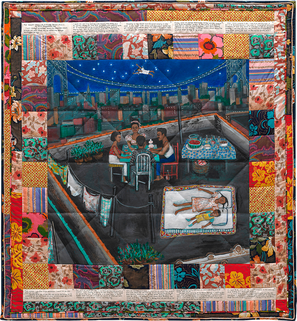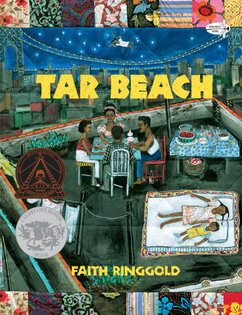By Jessica WhitelawLast week I was able to visit the long-awaited Faith Ringgold exhibit, American People, at the New Museum in New York. Many know Ringgold from her book Tar Beach, but this retrospective - her first - features Ringgold as artist/organizer/educator and showcases paintings, murals, political posters, sculptures, and story quilts that span the Harlem Renaissance, the Black Arts Movement, critical feminism, and reach into the landscape of contemporary Black artists working today. After years of a relationship with the book version of Tar Beach, it was moving to stand in front of the original story quilt that the book is based on, this intimate everyday object upon which she wrote, painted, and stitched, to push the boundaries of white western art traditions and explore themes of gender, race, class, history, and social transformation.
Below is a protocol adapted from the steps of art criticism that can be used to support students in developing picturebook practices that engage critical literacy and inquiry. It can be used with Tar Beach, whose content is both accessible and complex enough to use with both younger and older readers. But it offers a flexible participation structure that teachers can use with any picturebook that has rich visual/verbal content. Like most protocols, it works best as a flexible tool not a prescriptive device. Picturebook Read Aloud Protocol Adapted from the steps of art criticism, this protocol provides a framework for sharing picturebooks that aims to cultivate a critical practice. It guides the reader through a process of looking closely to notice what they might otherwise overlook and to use what they know about words and pictures to analyze and make sense of what they see. The stages offer a helpful way to support students of any age through a process and unfolding of critical engagement that relies upon attention to specific details in the work to guide thoughtful engagement and response. The protocol is intended as a facilitation guide for teachers. Wording should be adjusted for the audience/age of the reader. LOOK CLOSELY Take inventory. Examine the cover of the book, the dust jacket and the endpapers. Look closely at the typography, the pictures, the words. Describe what you see and notice in detailed, descriptive language. ANALYZE Use what you know about picturebooks and design to analyze the words and the pictures. Look at the colors, the lines, shapes, textures. Try to determine the media the artist used to make the pictures. Examine the style of the language the writer used. Look for patterns, repetition, rhyme. Draw attention to the picturebook as a unique form of the book that relies on the synergy of the words and the pictures by asking how the words and pictures work together: What do the words tell you that the pictures do not? What do the pictures tell you that the words do not? What happens in between the openings? QUESTION Use questions together to probe and deepen. Stop and ask questions about pages that are visually and/or verbally rich or complex. What sense do you make of this page? How do you know that? Why do you think the author or illustrator chose to do it the way they did? What questions does the page raise for you, make you wonder about? CRITIQUE What do you think the author/illustrator is trying to do or say or show in this book? Who do we see in this book? Who is the audience for this book? Who do you think should read it? Whose voice/voices do we hear? Who do we not hear from? What ideas do you have about the topic/topics in the book? What do you think the storyteller in this book believes or thinks or wants us to know? What questions do you have about what the storyteller is saying and showing? What genre/category does the book belong to? What other work has this author and/or illustrator created and how is it similar to or different from this book? RESPOND After having looked closely at the book, what does this text mean to you? What does the story make you wonder about? How could this story mean different things? To you? To different readers? Additional Teaching Resources for Tar Beach Watch Faith Ringgold read Tar Beach Create a paper story quilt Listen to Faith Ringgold’s favorite songs Explore a Faith Ringgold Text Set:
For Older Readers: Watch the Ted Talk by Kimberlé Crenshaw on intersectionality Examine how Tar Beach explores identity and power at several intersections. Examine other artworks of Faith Ringgold such as her For the Women’s House mural at the Brooklyn Museum or her America series of paintings on the artist’s website Read Ringgold’s feminist artist’s statement from her memoir, We Flew Over the Bridge. Look for themes that connect across and examine how the different art forms allow the themes to be explored differently. Read other excerpts from We Flew Over the Bridge: The Memoirs of Faith Ringgold, and examine how ideas from her life take shape in Tar Beach. Consider the different forms of visual and verbal storytelling that she employs in her work and how ideas are conveyed through different modalities in each. Jessica Whitelaw is faculty member at the University of Pennsylvania in the Graduate School of Education and a member of CLA. Comments are closed.
|
Authors:
|
CLA
About CLA
|
Journal of Children's Literature
Write for JCL
|
ResourcesCLA-sponsored NCTE Position Statements
|
Members-Only Content
CLA Video Library
|
© COPYRIGHT 2018.
ALL RIGHTS RESERVED |



 RSS Feed
RSS Feed